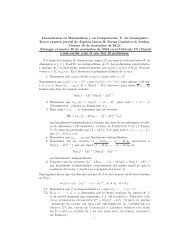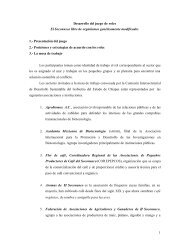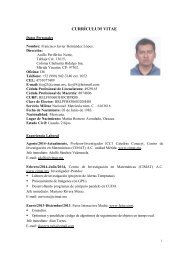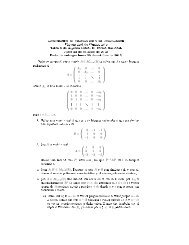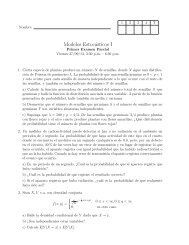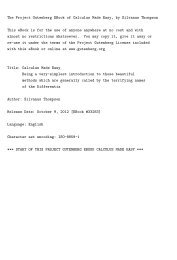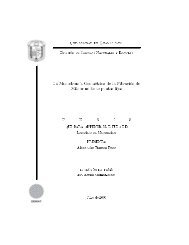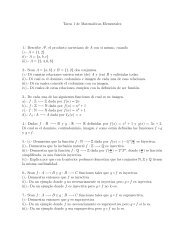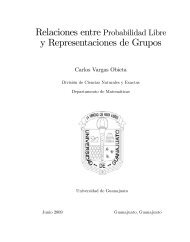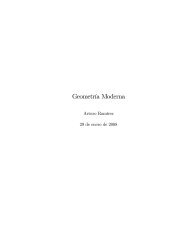Practical Parameterization of Rotations Using the Exponential Map ...
Practical Parameterization of Rotations Using the Exponential Map ...
Practical Parameterization of Rotations Using the Exponential Map ...
Create successful ePaper yourself
Turn your PDF publications into a flip-book with our unique Google optimized e-Paper software.
<strong>Practical</strong> <strong>Parameterization</strong> <strong>of</strong> <strong>Rotations</strong> <strong>Using</strong> <strong>the</strong> <strong>Exponential</strong> <strong>Map</strong><br />
F. Sebastian Grassia<br />
Carnegie Mellon University<br />
The final version <strong>of</strong> this paper is published in jgt, The Journal <strong>of</strong> Graphics Tools, volume 3.3, 1998.<br />
This reprint is included by permission <strong>of</strong> A K Peters, Ltd., publisher <strong>of</strong> jgt.<br />
Abstract<br />
Parameterizing three degree-<strong>of</strong>-freedom (DOF) rotations is difficult to do well. Many graphics applications demand that we<br />
be able to compute and differentiate positions and orientations <strong>of</strong> articulated figures with respect to <strong>the</strong>ir rotational (and o<strong>the</strong>r)<br />
parameters, as well as integrate differential equations, optimize functions <strong>of</strong> DOFs, and interpolate orientations. Widely used<br />
parameterizations such as Euler angles and quaternions are well suited to only a few <strong>of</strong> <strong>the</strong>se operations.<br />
The exponential map maps a vector in R 3 describing <strong>the</strong> axis and magnitude <strong>of</strong> a three DOF rotation to <strong>the</strong> corresponding rotation.<br />
Several graphics researchers have applied it with limited success to interpolation <strong>of</strong> orientations, but it has been virtually<br />
ignored with respect to <strong>the</strong> o<strong>the</strong>r operations mentioned above. In this paper we present formulae for computing, differentiating,<br />
and integrating three DOF rotations with <strong>the</strong> exponential map. We show that our formulation is numerically stable in <strong>the</strong> face<br />
<strong>of</strong> machine precision issues, and that for most applications all singularities in <strong>the</strong> map can be avoided through a simple technique<br />
<strong>of</strong> dynamic reparameterization. We demonstrate how to use <strong>the</strong> exponential map to solve both <strong>the</strong> “freely rotating body”<br />
problem, and <strong>the</strong> important ball-and-socket joint required to accurately model shoulder and hip joints in articulated figures.<br />
Examining several common graphics applications, we explain <strong>the</strong> benefits <strong>of</strong> our formulation <strong>of</strong> <strong>the</strong> exponential map over Euler<br />
angles and quaternions, including: robustness, small state vectors, lack <strong>of</strong> explicit constraints, good modeling capabilities, simplicity<br />
<strong>of</strong> solving ODE’s, and good interpolation behavior.<br />
1 Introduction<br />
There are many ways to parameterize rotations. Why we would want to use a particular parameterization (or any parameterization<br />
at all) depends entirely on its performance in applications <strong>of</strong> interest. The primary applications <strong>of</strong> rotations<br />
in graphics are to encode orientations and describe and control <strong>the</strong> motion <strong>of</strong> rigid bodies and articulations in transformation<br />
hierarchies. Hierarchies, <strong>the</strong> backbone <strong>of</strong> most character animation systems, require not only free rotations, but also<br />
constrained one, two, and three degree-<strong>of</strong>-freedom (DOF) rotations whose angular range <strong>of</strong> motion is limited to more<br />
faithfully model <strong>the</strong> motion <strong>of</strong>, e.g. human joints (we’ll explore ball-and-socket joints in section 5).<br />
Parameterizing rotations for <strong>the</strong>se applications is problematic mainly because rotations are non-Euclidean in nature<br />
(travelling infinitely far in any direction will bring you back to your starting point an infinite number <strong>of</strong> times). Any<br />
attempt to parameterize <strong>the</strong> entire set <strong>of</strong> three DOF rotations by an open subset <strong>of</strong> Euclidean space (as do Euler angles)<br />
will suffer from gimbal lock, <strong>the</strong> loss <strong>of</strong> rotational degrees <strong>of</strong> freedom, due to singularities 1 in <strong>the</strong> parameter space. <strong>Parameterization</strong>s<br />
that are <strong>the</strong>mselves defined over non-Euclidean spaces (such as <strong>the</strong> set <strong>of</strong> unit quaternions embedded in<br />
R 4 ) may remain singularity-free, and thus avoid gimbal lock. Employing such parameterizations is complicated, however,<br />
since <strong>the</strong> numerical tools most <strong>of</strong>ten employed in graphics assume Euclidean parameterizations; <strong>the</strong>refore we must ei<strong>the</strong>r<br />
develop new tools whose domains are non-Euclidean, or complicate our systems by imposing explicit constraints that<br />
1 Intuitively, a singularity is a continuous subspace <strong>of</strong> <strong>the</strong> parameter space, all <strong>of</strong> whose elements correspond to <strong>the</strong> same rotation – thus<br />
movement within <strong>the</strong> subspace produces no change in rotation.<br />
- 1 -
distinguish <strong>the</strong> non-Euclidean parameter space from <strong>the</strong> Euclidean space in which it is embedded (as we must impose<br />
constraints that ensure quaternions retain unit length).<br />
Every non-zero vector in R 3 has a direction and magnitude. We can associate a rotation with each vector by specifying<br />
<strong>the</strong> direction as an axis <strong>of</strong> rotation and <strong>the</strong> magnitude as <strong>the</strong> amount by which to rotate around <strong>the</strong> axis. If we augment<br />
this relationship by associating <strong>the</strong> zero vector with <strong>the</strong> identity rotation, <strong>the</strong> relationship is continuous, and is known as<br />
<strong>the</strong> exponential map. Unlike <strong>the</strong> quaternion parameterization, this parameterization is Euclidean, so it does contain singularities.<br />
The primary purpose <strong>of</strong> this paper is to show that for many common graphics applications, <strong>the</strong> singularities<br />
that cause gimbal lock in <strong>the</strong> exponential map are far away from <strong>the</strong> domain in which we must work, and that <strong>the</strong> resulting<br />
parameterization possesses most <strong>of</strong> <strong>the</strong> desirable qualities <strong>of</strong> <strong>the</strong> quaternion parameterization, without needing to worry<br />
about “falling <strong>of</strong>f” <strong>the</strong> unit quaternion sphere (or any o<strong>the</strong>r non-Euclidean manifold). We will also discuss <strong>the</strong> strengths<br />
and weaknesses <strong>of</strong> <strong>the</strong> exponential map and more commonly used parameterizations as applied to several important<br />
graphics applications, to aid <strong>the</strong> practitioner in selecting <strong>the</strong> correct parameterization for <strong>the</strong> job.<br />
In section 2 we examine how rotations are used in graphics applications and describe <strong>the</strong> pros and cons <strong>of</strong> <strong>the</strong> most<br />
commonly used parameterizations. Then in section 3 we develop <strong>the</strong> exponential map, and explain why it is advantageous<br />
to map into quaternions instead <strong>of</strong> mapping from R 3 directly to rotation matrices, and present formulae for computing<br />
quaternions and differentiating <strong>the</strong>m with respect to R 3 . In section 4 we show that this parameterization is extremely<br />
well suited to <strong>the</strong> applications <strong>of</strong> differential control and forward dynamics, and also discuss its limitations when<br />
applied to interpolation and spacetime optimization. In section 5 we fur<strong>the</strong>r motivate <strong>the</strong> constrained three DOF rotation,<br />
and extend our method straightforwardly to handle it. We conclude in section 6 with a summary <strong>of</strong> <strong>the</strong> strengths and<br />
limitations <strong>of</strong> our formulation, and include in <strong>the</strong> appendices pseudocode and a pointer to supplemental C code for computing<br />
and differentiating using our formulation <strong>of</strong> <strong>the</strong> exponential map.<br />
2 Evaluation <strong>of</strong> Common <strong>Parameterization</strong>s<br />
There are five primitive means <strong>of</strong> describing and controlling rotations in graphics: forward kinematics (including keyframe<br />
interpolation), inverse kinematics, forward and inverse dynamics, and spacetime optimization. We will not consider<br />
o<strong>the</strong>r, higher level methods such as procedural animation and motion controllers, because <strong>the</strong>y can generally be<br />
expressed in terms <strong>of</strong> <strong>the</strong> above primitives.<br />
The applications built upon <strong>the</strong>se primitives, several <strong>of</strong> which we will discuss in section 4, vary considerably in <strong>the</strong> size<br />
and complexity <strong>of</strong> <strong>the</strong> motion problems <strong>the</strong>y address; however, <strong>the</strong>y all require some or all <strong>of</strong> <strong>the</strong> following operations:<br />
1. <strong>the</strong> ability to compute positions and orientations <strong>of</strong> points on body parts as functions <strong>of</strong> <strong>the</strong> parameters (e.g. position<br />
and direction <strong>of</strong> a humanoid’s pointing finger), which is one aspect <strong>of</strong> forward kinematics<br />
2. <strong>the</strong> existence <strong>of</strong> and <strong>the</strong> ability to compute derivatives <strong>of</strong> <strong>the</strong>se positions and orientations with respect to <strong>the</strong> parameters,<br />
which is necessary for inverse kinematics, dynamics, and spacetime<br />
3. <strong>the</strong> ability to integrate ordinary differential equations (ODEs) in parameter space, which is also required by inverse<br />
kinematics, dynamics, and spacetime<br />
4. <strong>the</strong> ability to interpolate smoothly and controllably between sequences <strong>of</strong> parameter keyframes<br />
5. <strong>the</strong> ability to combine rotations, ei<strong>the</strong>r in <strong>the</strong> parameter space or in rotation space itself<br />
6. <strong>the</strong> existence <strong>of</strong> an inverse operation that calculates parameter values from <strong>the</strong> corresponding rotation<br />
Operations 3 and 4, and sometimes 5, naturally occur in <strong>the</strong> parameter space itself. Operations 1 and 2, however, are<br />
most conveniently carried out by expressing <strong>the</strong> rotation as a 4x4 transformation matrix, since this allows rotations to be<br />
included at any articulation in a transformation hierarchy right alongside translations, scales, and o<strong>the</strong>r linear transformations<br />
2 . This gives us a common baseline for computation across various parameterizations: we will be interested in computing<br />
a rotation matrix and <strong>the</strong> partial derivatives <strong>of</strong> that rotation matrix with respect to its parameters. Therefore, if <strong>the</strong><br />
parameterization possesses an n element vector <strong>of</strong> parameters v, we must be able to compute:<br />
2 See Welman[11] for a method <strong>of</strong> computing Jacobians for hierarchies <strong>of</strong> only translations and rotations that does not involve transformation<br />
matrices. This is also an excellent introduction to inverse kinematics.<br />
- 2 -
Rv ( ) and ∂ R<br />
∂v<br />
where R is a 4x4 matrix and ∂R<br />
∂v is a 4x4xn tensor, that is, an n element vector <strong>of</strong> 4x4 matrices, each <strong>of</strong> which is <strong>the</strong><br />
partial derivative <strong>of</strong> R with respect to one <strong>of</strong> <strong>the</strong> n parameters in v. From <strong>the</strong>se we can easily compute <strong>the</strong> jacobians <strong>of</strong><br />
points and orientations with respect to <strong>the</strong> parameters, as demonstrated in <strong>the</strong> supplementary pseudocode (see Appendix).<br />
Now that we know <strong>the</strong> quantities we are interested in computing, we can examine <strong>the</strong> parameterizations in use today and<br />
see where and why <strong>the</strong>y are unsatisfactory.<br />
2.1 3x3 Rotation Matrices<br />
Each rotation can be represented as a 3x3 matrix whose columns are <strong>of</strong> unit length and are mutually orthogonal, and<br />
whose determinant is 1.0. The set <strong>of</strong> all such matrices forms <strong>the</strong> group SO(3) under <strong>the</strong> operation <strong>of</strong> matrix multiplication,<br />
and each member <strong>of</strong> <strong>the</strong> group in turn corresponds to a rotation. Since we have already stipulated that we are primarily<br />
interested in generating rotation matrices from our parameters, why not simply take <strong>the</strong> nine elements <strong>of</strong> <strong>the</strong> rotation<br />
matrix as our parameterization? If we were to do so, a rotation becomes a linear function <strong>of</strong> its parameters, which not<br />
only means that <strong>the</strong> rotation and its partial derivatives are trivial to compute, but also that we can potentially use linear<br />
optimization in our control algorithms, since positions and orientations on articulated figures will be linear functions <strong>of</strong><br />
<strong>the</strong> parameters (translations, <strong>the</strong> o<strong>the</strong>r common transformation used in hierarchies, are also linear functions <strong>of</strong> <strong>the</strong>ir parameters).<br />
Unfortunately, to optimize or differentially control using this parameterization, we must impose six non-linear constraints<br />
to ensure <strong>the</strong> matrix remains in SO(3) as its nine parameters are independently altered (three constraints to maintain<br />
unit length <strong>of</strong> all three columns, and three to keep <strong>the</strong>m mutually orthogonal 3 ). Similarly, each step taken while<br />
integrating an ODE will require that each rotation be re-orthonormalized.<br />
2.2 Euler Angles<br />
An Euler angle is a DOF that represents a rotation about one <strong>of</strong> <strong>the</strong> coordinate axes. There are three distinct functions<br />
Rx , R y , and Rz for computing rotation matrices, depending on <strong>the</strong> coordinate axis about which <strong>the</strong> Euler angle rotates.<br />
These functions involve <strong>the</strong> sine and cosine <strong>of</strong> <strong>the</strong> Euler angle, and, although <strong>the</strong>se functions are nonlinear, <strong>the</strong>ir derivatives<br />
are easy to compute.<br />
The problems in applying Euler angles to our intended applications are well known in graphics [9]. Three DOF Euler<br />
rotations, formed by concatenating three single-axis rotations, suffer from gimbal lock when two <strong>of</strong> <strong>the</strong> three rotation axes<br />
align, causing a rotational DOF to be lost. This means <strong>the</strong>re is a direction in which <strong>the</strong> mechanism whose orientation is<br />
being controlled by <strong>the</strong> Euler rotation cannot respond to applied forces and torques – it “locks up.” It is straightforward to<br />
place limits on <strong>the</strong> legal range <strong>of</strong> motion for Euler angles, but since gimbal lock typically occurs when <strong>the</strong> second rotation<br />
in <strong>the</strong> chain has value 0 or π/2 (depending on <strong>the</strong> choice <strong>of</strong> Euler angles), we will not be able to avoid gimbal lock even<br />
for ball-and-socket joints, because, for example, shoulder joints require a range <strong>of</strong> rotation greater than π/2. Fur<strong>the</strong>rmore,<br />
interpolation <strong>of</strong> Euler angles results in poor interpolation <strong>of</strong> rotations, since Euler angles interpolate about each <strong>of</strong> <strong>the</strong><br />
three axes independently, ignoring <strong>the</strong> interaction between <strong>the</strong> axes that arises from rotations’ non-Euclidean nature.<br />
Euler angles are quite suitable for integrating ODEs, but since inverse kinematics, dynamics, and spacetime optimization<br />
require (at least) freedom from gimbal lock, Euler angles are unsuitable for <strong>the</strong>se applications. We should note, however,<br />
that Euler angles provide an easy to use interface to animators in <strong>the</strong> form <strong>of</strong> three independent sliders (or <strong>the</strong> equivalent),<br />
and also work quite well in all applications requiring one or two DOF rotations.<br />
3 The seventh constraint defining SO(3), that determinant = 1.0 (as opposed to –1.0, <strong>the</strong> only o<strong>the</strong>r possibility), is subtly dependent on<br />
<strong>the</strong> o<strong>the</strong>r six, and generally does not require explicit enforcement.<br />
- 3 -
2.3 Quaternions<br />
Quaternions have a rich ma<strong>the</strong>matics and history, including bitterly losing out to vector algebra as <strong>the</strong> accepted ma<strong>the</strong>matical<br />
foundation for classical mechanics [8]. However, <strong>the</strong> reader <strong>of</strong> this paper will probably be familiar with quaternions,<br />
as presented to <strong>the</strong> graphics community by Shoemake [9], so we will only touch <strong>the</strong> highlights before discussing<br />
<strong>the</strong>ir strengths and weaknesses.<br />
Quaternions form a group whose underlying set is <strong>the</strong> four dimensional vector space R 4 , with a multiplication operator<br />
‘o ’ that combines both <strong>the</strong> dot product and cross product <strong>of</strong> vectors [9]. The set <strong>of</strong> unit-length quaternions is a sub-group<br />
whose underlying set is named S 3 . Quaternions are <strong>of</strong> interest to graphicists, roboticists, and mechanical engineers primarily<br />
because we can use S 3 to describe and carry out rotations. We do this by interpreting members <strong>of</strong> S 3 like so:<br />
T<br />
The quaternion q = 0001 ,,,<br />
corresponds to <strong>the</strong> identity rotation.<br />
T<br />
The quaternion q = q , q , q , q<br />
x y z w<br />
−1<br />
encodes a rotation <strong>of</strong> θ = 2cos ( q w<br />
) radians about<br />
1<br />
<strong>the</strong> unit axis v $ =<br />
−<br />
sin(cos<br />
1<br />
( q ) )<br />
w<br />
T<br />
x y z<br />
.<br />
q , q , q<br />
In o<strong>the</strong>r words, we may parameterize a rotation <strong>of</strong> radians about <strong>the</strong> unit axis v$ ∈R<br />
3 with a unit quaternion constructed<br />
like so:<br />
1<br />
1<br />
q= q , q , q , q = sin( θ)$, v cos( θ)<br />
x y z w<br />
T<br />
2<br />
2<br />
T<br />
The interesting thing is that if we want to rotate a vector x ∈R 3<br />
by <strong>the</strong> rotation encoded in q ∈S 3 , we can carry it out<br />
using only quaternion multiplication:<br />
x ′= Rotate(x) = qo<br />
~<br />
xoq<br />
where ~ x is <strong>the</strong> vector x extended with a zero scalar component to make a quaternion, and q is <strong>the</strong> conjugate <strong>of</strong> q (q<br />
with its vector part negated) 4 . One can prove that <strong>the</strong> result <strong>of</strong> <strong>the</strong> quaternion multiplications in this case will always have<br />
a zero scalar component, so <strong>the</strong> last step <strong>of</strong> <strong>the</strong> ‘Rotate’ function simply strips <strong>of</strong>f <strong>the</strong> scalar part to arrive at x ′. Fur<strong>the</strong>rmore,<br />
<strong>the</strong>re are simple formulae for computing a rotation matrix R( q) and its partial derivatives from a unit quaternion;<br />
one such is given by Shoemake [9] 5 . The four partial derivatives ∂R ∂q x<br />
, ∂R ∂q y<br />
,∂R ∂q z<br />
, and∂R<br />
∂q w<br />
exist and are<br />
linearly independent over all <strong>of</strong> S 3 , which means that unit quaternions are free from gimbal lock when used to control<br />
orientations.<br />
However, this scheme relies on quaternions remaining in S 3 (i.e., maintaining unit length) throughout <strong>the</strong> process <strong>of</strong><br />
differential control, optimization, integration, etc. Since <strong>the</strong>re are four directions in which a quaternion can change, but<br />
only three rotational DOFs, an optimizer or differential control algorithm is free to move <strong>the</strong> quaternion <strong>of</strong>f <strong>the</strong> unit quaternion<br />
sphere, leading to non-rotations. Integrating ODEs in parameter space is also problematic because <strong>the</strong> instantaneous<br />
velocity or direction <strong>of</strong> change &q generally lies in <strong>the</strong> tangent plane to S 3 , and any movement in <strong>the</strong> tangent plane to<br />
S 3 will push <strong>the</strong> quaternion out <strong>of</strong> S 3 .<br />
Several strategies have been developed to deal with <strong>the</strong>se complications. The integration problem is generally addressed<br />
by re-normalizing <strong>the</strong> quaternion after every integration step, relying on small stepsizes to prevent <strong>the</strong> error from<br />
getting out <strong>of</strong> control. The “four derivative / three DOF” problem is typically dealt with in one <strong>of</strong> two ways. One can<br />
impose explicit constraints that force quaternions to maintain <strong>the</strong>ir unit length; this generally suffices (as long as <strong>the</strong>se<br />
4 A slightly altered rotation formula uses <strong>the</strong> inverse <strong>of</strong> q instead <strong>of</strong> its conjugate, and produces rotations from non-unit quaternions as<br />
well. However, this formulation is undefined at <strong>the</strong> origin; fur<strong>the</strong>rmore, rotating vectors this way is not very convenient for use in<br />
transformation hierarchies, and results in far more complicated derivatives than using rotation matrices.<br />
5 The rotation matrix M presented in [9] transforms row vectors, so is actually <strong>the</strong> transpose <strong>of</strong> <strong>the</strong> matrix R that we desire for<br />
transforming column vectors. Our convention for rotating vectors by quaternions is also <strong>the</strong> opposite <strong>of</strong> that in [9], but is consistent<br />
with transforming column vectors.<br />
- 4 -
constraints have higher precedence than o<strong>the</strong>r constraints that might be imposed), but increases <strong>the</strong> size <strong>of</strong> <strong>the</strong> systems we<br />
must solve, thus degrading performance. One can also use a function for Rq ( ) that is defined over all <strong>of</strong> R 4 (except <strong>the</strong><br />
zero element), like <strong>the</strong> autonormalizing formulae presented by Gleicher [2] (or, similarly, <strong>the</strong> function discussed in footnote<br />
4). The problem with this method is that <strong>the</strong> Jacobian becomes rank deficient, which means that <strong>the</strong>re is a direction<br />
in R 4 along which <strong>the</strong> quaternion can change without producing any change in orientation. One effect <strong>of</strong> this is to corrupt<br />
(make singular) <strong>the</strong> mass matrix, which is commonly used to achieve parameterization-independent scaling <strong>of</strong> simulated<br />
physical systems[12].<br />
S 3 is an excellent place to interpolate rotations because it possesses <strong>the</strong> same local geometry and topology as SO( 3 ) .<br />
Indeed, <strong>the</strong> results <strong>of</strong> interpolating with quaternions are generally pleasing to <strong>the</strong> eye, and can be made to possess<br />
desirable variational properties [9] [1] [6]. Recently, Kim et. al. [6] developed closed form quaternion curves on S 3 using<br />
Bezier, Hermite, B-spline (or indeed, any) blending functions, and were able to calculate high order parametric derivatives<br />
over <strong>the</strong> curves. This is great news for applications that must compute and optimize or integrate along fixed orientation<br />
curves, but it does not aid greatly in differential control or optimization over <strong>the</strong> curve shape itself, since it provides no<br />
correspondingly simple method for differentiating <strong>the</strong> curve with respect to <strong>the</strong> quaternion control points, and even if it<br />
did we would still face <strong>the</strong> inconveniences described in <strong>the</strong> preceding paragraphs. Never<strong>the</strong>less, <strong>the</strong> ability to specify<br />
closed form Hermite curves on S 3 by quaternion keys and angular velocities at <strong>the</strong> keys seems promising for use in keyframe<br />
animation systems, given suitable methods for visualizing <strong>the</strong> quaternion curves.<br />
In summary, use <strong>of</strong> quaternions to parameterize rotations leads to numerically well-conditioned systems in <strong>the</strong> applications<br />
under consideration, but incurs an overhead in efficiency and/or code complexity whenever derivatives are used for<br />
control or optimization. Especially in light <strong>of</strong> recent developments, however, <strong>the</strong>y may be <strong>the</strong> best choice for interpolation<br />
<strong>of</strong> three DOF rotations.<br />
3 The <strong>Exponential</strong> <strong>Map</strong><br />
The problems we encounter with <strong>the</strong> quaternion parameterization arise because only a subspace <strong>of</strong> <strong>the</strong> full quaternion<br />
parameter space represents rotations. Given that we are interested in parameterizing a three DOF rotation, we would like<br />
a parameterization embedded in R 3 that is free <strong>of</strong> gimbal lock and interpolates rotations well using Euclidean interpolants<br />
such as cubic splines. This goal is, <strong>of</strong> course, unrealizable, as it is a standard exercise in topology to show that R 3 cannot<br />
be mapped into SO( 3 ) without singularities, i.e. gimbal lock. However, as we will now show, <strong>the</strong> inevitable singularities<br />
in <strong>the</strong> exponential map are <strong>of</strong>ten avoidable.<br />
The exponential map maps a vector in R 3 describing <strong>the</strong> axis and magnitude <strong>of</strong> a three DOF rotation to <strong>the</strong> corresponding<br />
rotation. There are many different formulations <strong>of</strong> <strong>the</strong> exponential map 6 . One map popular in robotics texts is <strong>the</strong><br />
matrix exponential, which maps R 3 into SO(3) by summing an infinite series <strong>of</strong> exponentiated skew-symmetric matrices;<br />
<strong>the</strong> infinite series is generally evaluated using <strong>the</strong> compact Rodrigues’ Formula[7]. However, we have found several<br />
advantages to using a map from R 3 to S 3 , and using standard quaternion-to-matrix formulae for conversion to SO(3).<br />
Among <strong>the</strong> advantages are that <strong>the</strong> inverse <strong>of</strong> <strong>the</strong> exponential map, <strong>the</strong> log map from S 3 to R 3 , is much simpler than <strong>the</strong> log<br />
map from SO(3) to R 3 (we require <strong>the</strong> log map to derive some important auxiliary quantities, for example see section 4.1),<br />
and that it may be useful to easily convert to and from S 3 when one needs to perform optimal interpolation (section 4.2) or<br />
spacetime optimization (section 0).<br />
We can formulate an exponential map from R 3 to S 3 as follows:<br />
e [ , , ] T<br />
000<br />
T<br />
= 0001 ,,, and for v≠ 0 e<br />
∞<br />
v<br />
1 m<br />
=<br />
2<br />
v =<br />
m=<br />
0<br />
∑( ~ 1<br />
1<br />
) sin( )$, v cos( ) T<br />
2<br />
θ<br />
2<br />
θ ,<br />
6 Given that <strong>the</strong> idea <strong>of</strong> raising a scalar base to a non-scalar power is at best tenuously intuitive, why do we use <strong>the</strong> term exponential<br />
map? Historically, <strong>the</strong> formulation <strong>of</strong> <strong>the</strong> map as an infinite series has <strong>the</strong> same form as <strong>the</strong> series expansion <strong>of</strong> <strong>the</strong> exponential e x<br />
real numbers x, and thus <strong>the</strong> ma<strong>the</strong>matical community has adopted <strong>the</strong> name exponential for <strong>the</strong> map.<br />
for<br />
- 5 -
where θ =| v | and v$ = v | v|<br />
, which maps v to a unit quaternion representing a rotation <strong>of</strong> θ (i.e. | v | ) about v, where<br />
( ~ 1<br />
2<br />
v)<br />
m is computed using quaternion multiplication. The formula on <strong>the</strong> right should look familiar: it is exactly <strong>the</strong> formula<br />
we used in section 2.3 to create a unit quaternion from a (unit) axis / angle description <strong>of</strong> a rotation. But now <strong>the</strong><br />
exponential map has allowed us to encode both magnitude and axis <strong>of</strong> a rotation into a single three-vector.<br />
The only problem with this particular formulation is that calculating v$ = v | v|<br />
as | v | goes to zero becomes numerically<br />
unstable. However, by rearranging <strong>the</strong> above formula a bit, we will be able to see that this exponential map can be computed<br />
robustly even in <strong>the</strong> neighborhood <strong>of</strong> <strong>the</strong> origin.<br />
Let<br />
q<br />
v<br />
e v 1<br />
1<br />
sin(<br />
2<br />
θ ) , cos(<br />
2<br />
θ ) θ<br />
= = !<br />
" $ # = !<br />
T<br />
1<br />
sin( 2 θ )<br />
1<br />
v,cos( 2<br />
θ )<br />
θ<br />
All we have done is reorganize <strong>the</strong> problematic term so that instead <strong>of</strong> computing v | v| (i.e. v θ ), we compute<br />
1<br />
1<br />
1 1<br />
sin(<br />
2<br />
θ ) θ . Why? Because sin(<br />
2<br />
θ ) θ =<br />
2<br />
sinc(<br />
2<br />
θ ) , and sinc is a function that is known to be computable and continuous<br />
at and around zero. Assured that <strong>the</strong> function is computable, we still need a formula for computing it, since sinc is<br />
not included in standard math libraries. Availing ourselves to <strong>the</strong> Taylor Expansion <strong>of</strong> sine, we get:<br />
1<br />
sin( 2 θ ) 1<br />
1<br />
= TaylorExpansion(sin(<br />
2<br />
θ ))<br />
θ θ<br />
<br />
<br />
3 5<br />
16 16<br />
L<br />
θ θ<br />
1 θ 2 2<br />
= + − +<br />
θ 2 3! 5!<br />
2 4<br />
1 θ θ<br />
= + − + L<br />
5<br />
2 48 2 ⋅5!<br />
From this we see that <strong>the</strong> term is well defined, and that evaluating <strong>the</strong> entire infinite series would give us <strong>the</strong> exact<br />
value. But as θ → 0 , each successive term is smaller than <strong>the</strong> last, and terms are alternately added and subtracted, so if<br />
we approximate <strong>the</strong> true value by <strong>the</strong> first n terms, <strong>the</strong> error will be no greater than <strong>the</strong> magnitude <strong>of</strong> <strong>the</strong> n+1’st term. In<br />
fact, since machine precision is limited, we can evaluate <strong>the</strong> function with no numerical error like so:<br />
4<br />
When θ ≤ machine precision use just <strong>the</strong> first two terms <strong>of</strong> <strong>the</strong> expansion:<br />
1<br />
2<br />
sin( 2 θ ) 1 θ<br />
= + ;<br />
θ 2 48<br />
o<strong>the</strong>rwise perform <strong>the</strong> actual sine computation and division by θ . Since all <strong>the</strong> dropped terms involve factors <strong>of</strong> θ , <strong>the</strong><br />
approximation and actual function agree at θ = 0 .<br />
<br />
<br />
"<br />
$#<br />
T<br />
3.1 Derivatives<br />
Since we are in essence reparameterizing quaternions, we can compute <strong>the</strong> derivatives <strong>of</strong> R (<strong>the</strong> rotation matrix) with<br />
respect to its exponential map parameters by applying <strong>the</strong> chain rule. That is, we have R( qv ( ))<br />
and wish to compute<br />
∂R<br />
∂v, which we can compute as <strong>the</strong> product:<br />
∂R<br />
∂R<br />
∂q<br />
=<br />
∂v<br />
∂q<br />
∂v<br />
Since we already know how to compute <strong>the</strong> partial derivatives ∂R<br />
∂q, <strong>the</strong> only new quantities we need are <strong>the</strong> twelve<br />
partial derivatives <strong>of</strong> <strong>the</strong> quaternion with respect to its exponential map parameters (here ∂q<br />
∂v), which follow. Additionally,<br />
<strong>the</strong> appendix discusses <strong>the</strong> supplemental C source code for computing R, ∂R<br />
∂v, and o<strong>the</strong>r quantities presented<br />
later in this paper.<br />
To express <strong>the</strong> similarity in <strong>the</strong> form <strong>of</strong> <strong>the</strong> twelve derivatives, we let l range over <strong>the</strong> three components <strong>of</strong> q that<br />
make up its vector part, and let n range over <strong>the</strong> components <strong>of</strong> v.<br />
The formulae for computing <strong>the</strong> partial derivatives <strong>of</strong> q with respect to v are, in <strong>the</strong> usual case where q >> 0:<br />
- 6 -
1<br />
∂qw<br />
sin(<br />
1<br />
2 θ)<br />
=− 2 vn<br />
∂v<br />
θ<br />
n<br />
1<br />
1<br />
1<br />
∂q<br />
1 2<br />
cos( 2 θ) 2<br />
sin( 2 θ) sin( 2 θ)<br />
l<br />
When l = n:<br />
= 2 v − v +<br />
n 2<br />
n 3<br />
∂v<br />
θ θ θ<br />
n<br />
1<br />
1<br />
∂q<br />
cos(<br />
1<br />
2 θ) sin( 2 θ)<br />
l<br />
When l ≠ n:<br />
= 2 vv −vv<br />
l n 2<br />
l n 3<br />
∂vn<br />
θ<br />
θ<br />
In <strong>the</strong> neighborhood <strong>of</strong> q – 0 , we can again replace sine and cosine by <strong>the</strong>ir Taylor expansions, and after simplifying,<br />
discard all terms with powers θ 4<br />
or greater in <strong>the</strong> numerator. The result is <strong>the</strong> following forms for computing <strong>the</strong> partial<br />
derivatives <strong>of</strong> q :<br />
2<br />
1 θ<br />
Let TSinc16 1<br />
1<br />
θ = − The simplification <strong>of</strong> TaylorExp2sin1 θ67 2<br />
θ<br />
<br />
2 48<br />
∂q<br />
∂v<br />
w<br />
n<br />
=− 1 2 v TSinc( θ )<br />
n<br />
2 2<br />
∂q<br />
v<br />
l n<br />
θ <br />
When l = n: = − 1 TSinc<br />
∂v<br />
<br />
n + θ<br />
24 40<br />
2<br />
∂q<br />
vv<br />
l<br />
l n θ <br />
When l ≠ n:<br />
= − 1<br />
∂v<br />
<br />
24 40<br />
n<br />
<br />
<br />
05<br />
3.2 Limitations<br />
So far our formulation <strong>of</strong> <strong>the</strong> exponential map seems to fulfill all <strong>of</strong> our requirements, parameterizing an axis/angle<br />
rotation in three Euclidean parameters. Before we can discuss its application to <strong>the</strong> animation problems we have talked<br />
about, we must be clear about what we have given up (versus a straight quaternion parameterization).<br />
3.2.1 Singularities<br />
For <strong>the</strong> purposes <strong>of</strong> control and simulation, <strong>the</strong> principal advantage <strong>of</strong> quaternions over Euler angles is <strong>the</strong>ir freedom<br />
from gimbal lock. We already know that <strong>the</strong> exponential map must have singularities, so if it is to be useful, we must<br />
locate all singularities and show how <strong>the</strong>y can be avoided at a cost that is outweighed by its benefits.<br />
The exponential map has singularities on <strong>the</strong> spheres (in R 3 ) <strong>of</strong> radius 2Q (for n=1,2,3,…). This makes sense, since a<br />
rotation <strong>of</strong> 2 about any axis is equivalent to no rotation at all – <strong>the</strong> entire shell <strong>of</strong> points 2 distant from <strong>the</strong> origin (and<br />
4 , etc.) collapses to <strong>the</strong> identity in SO( 3 ) . So if we can restrict our parameterization to <strong>the</strong> inside <strong>of</strong> <strong>the</strong> ball <strong>of</strong> radius 2 ,<br />
we will avoid <strong>the</strong> singularity. Fortunately, each member <strong>of</strong> SO(3) (except <strong>the</strong> rotation <strong>of</strong> zero radians) has two possible<br />
representations within this ball: as a rotation <strong>of</strong> q radians about v, and as a rotation <strong>of</strong> 2p - q radians about −v.<br />
Because both control and simulation operate by moving through time in small steps, and <strong>the</strong> possible change in rotation<br />
on each step is small (certainly less than ), we can easily keep orientations inside <strong>the</strong> ball like so: at each time step when<br />
<strong>the</strong> rotation is queried for its value and derivative, we examine v , and if it is close to , 7 we replace v by ( 1− 2π v)<br />
v,<br />
which is an equivalent rotation, but with better derivatives. Such dynamic reparameterization could, in <strong>the</strong>ory, also be<br />
applied to avoiding gimbal lock in Euler angles, but whereas here <strong>the</strong> reparameterization simply scales <strong>the</strong> current parameters,<br />
<strong>the</strong> corresponding operation on Euler angles involves switching <strong>the</strong> functions that define <strong>the</strong> rotation matrix and<br />
a sequence <strong>of</strong> inverse trig functions to determine <strong>the</strong> new parameters [10]. However, we must point out that this<br />
reparameterization deprives us <strong>of</strong> <strong>the</strong> ability to simply interpolate between successive state-snapshots produced by a<br />
simulator or inverse kinematics animation engine; before doing so we must make sure <strong>the</strong> consecutive rotation values are<br />
“close” to each o<strong>the</strong>r in R 3 (see section 4.2).<br />
7 We choose ra<strong>the</strong>r than 2 because it gives us <strong>the</strong> maximal “buffer zone” against abnormally large steps, while still allowing all<br />
orientations to be representable.<br />
- 7 -
3.2.2 Combining <strong>Rotations</strong><br />
One nice feature <strong>of</strong> quaternions is that <strong>the</strong> multiplication operator corresponds to matrix multiplication <strong>of</strong> rotation matrices.<br />
That is, if q 1<br />
and q 2<br />
are unit quaternions, <strong>the</strong>n <strong>the</strong> combined rotation that is <strong>the</strong> result <strong>of</strong> first rotating by q 1<br />
and<br />
<strong>the</strong>n by q 2<br />
corresponds to <strong>the</strong> unit quaternion q = q o q . R 3 under <strong>the</strong> exponential map possesses no simple analogous<br />
3 2 1<br />
operation. To compute v 3<br />
, <strong>the</strong> vector corresponding to <strong>the</strong> combined rotation <strong>of</strong> first rotating by v 1<br />
and <strong>the</strong>n by v 2<br />
, we<br />
would need to map v 1<br />
and v 2<br />
to <strong>the</strong>ir corresponding quaternions, perform quaternion multiplication, <strong>the</strong>n convert back,<br />
incurring several trig and one inverse trig functions.<br />
Fortunately, this operation is typically not needed in <strong>the</strong> inner loops <strong>of</strong> <strong>the</strong> applications we have talked about. <strong>Rotations</strong><br />
are changed only by direct parameter manipulation, or incrementally, via <strong>the</strong>ir derivatives. When <strong>the</strong>y are combined, it is<br />
usually in <strong>the</strong> context <strong>of</strong> a transformation hierarchy, where all rotations have already been converted into transformation<br />
matrices.<br />
4 Applications<br />
Now that we have seen how <strong>the</strong> exponential map works and what its <strong>the</strong>oretical limitations are, it is time to focus on <strong>the</strong><br />
reason we are presenting it: <strong>the</strong> simplification <strong>of</strong> algorithms that use parameterized rotations. Of <strong>the</strong> four applications we<br />
have discussed in this paper – control, simulation, optimization, and interpolation – we believe <strong>the</strong> exponential map to be<br />
very well suited to <strong>the</strong> tasks <strong>of</strong> differential control and simulation (forward dynamics plus integration). In <strong>the</strong> following<br />
sections we will explain why, and also discuss <strong>the</strong> complications that arise in applying it to interpolation and optimization.<br />
4.1 Differential Control and Dynamics Simulation<br />
One <strong>of</strong> <strong>the</strong> motivating applications for this work is differential control, which enables direct manipulation interfaces,<br />
inverse kinematics, and real-time control <strong>of</strong> robotic manipulators. To control <strong>the</strong> positions and velocities <strong>of</strong> objects and<br />
end-effectors <strong>of</strong> articulated assemblies, <strong>the</strong> only demands imposed by differential control are that <strong>the</strong> derivatives ∂R<br />
∂v<br />
be continuous and free from gimbal lock. Since control is only performed at discrete instants in time, <strong>the</strong> simple dynamic<br />
reparameterization technique presented in section 3.2.1 will assure that <strong>the</strong>se demands are always met.<br />
In dynamics simulation applications, we track not only an object’s instantaneous position and pose, but also its linear<br />
and angular velocity. Linear velocity is stored as a 3-vector that represents <strong>the</strong> Cartesian direction and magnitude <strong>of</strong> <strong>the</strong><br />
velocity. Angular velocity is also represented as a 3-vector ω , whose meaning is nearly identical to that <strong>of</strong> <strong>the</strong> exponential<br />
map, except that its magnitude represents <strong>the</strong> rate <strong>of</strong> rotation about <strong>the</strong> axis ra<strong>the</strong>r than absolute orientation.<br />
To update <strong>the</strong> position and orientation correctly as <strong>the</strong> simulation moves forward in time, we need, in addition to <strong>the</strong><br />
derivatives necessary for differential control, a formula for mapping <strong>the</strong> instantaneous angular velocity into <strong>the</strong> tangent<br />
space <strong>of</strong> our parameterization. For a quaternion orientation <strong>the</strong> formula is <strong>the</strong> following [5]:<br />
q& =<br />
~<br />
1 2 ω o q,<br />
where ω ~ is <strong>the</strong> angular velocity vector ω extended with a zero scalar component to make a quaternion. In <strong>the</strong> above<br />
formula and <strong>the</strong> subsequent ones, we have not explicitly denoted that q is actually a function <strong>of</strong> time, q0t5, and thus &q is<br />
its time derivative.<br />
To derive a similar formula for &v, we make use <strong>of</strong> <strong>the</strong> inverse <strong>of</strong> <strong>the</strong> exponential map, dubbed, appropriately, <strong>the</strong> “log”<br />
map from S 3 to R 3 , whose co-domain is rotations <strong>of</strong> magnitude less than π . Implicit differentiation gives us:<br />
−1<br />
2 cos ( q q<br />
v = log( q)<br />
=<br />
w<br />
)<br />
∂ log<br />
q , Therefore v&<br />
= q&<br />
=<br />
v<br />
| q |<br />
∂q<br />
v<br />
0 5 0 5<br />
o<br />
∂ log q<br />
1<br />
~<br />
2 ω<br />
∂q<br />
where q v<br />
is <strong>the</strong> vector part <strong>of</strong> <strong>the</strong> quaternion. When we take <strong>the</strong> derivative <strong>of</strong> <strong>the</strong> log function with respect to q and put<br />
<strong>the</strong> entire formula on <strong>the</strong> right in terms <strong>of</strong> v, much simplification occurs. We end up with <strong>the</strong> following formula for &v in<br />
terms <strong>of</strong> v and ω , which contains roughly <strong>the</strong> same number and kind <strong>of</strong> operations that <strong>the</strong> quaternion multiplication to<br />
compute &q would have required.<br />
q<br />
- 8 -
In <strong>the</strong> normal case where q >> 0:<br />
ω ⋅v<br />
2<br />
1<br />
1<br />
Let p= ω × v γ = θcot( 2 θ) η = cot( 2 θ)<br />
−<br />
θ<br />
θ<br />
Then v& = 1<br />
2 ( γ ω + p−ηv)<br />
<br />
<br />
<br />
<br />
1<br />
1<br />
1<br />
In <strong>the</strong> limit as q – 0 , Taylor expansions <strong>of</strong> cot( 2 q) = cos( 2 q) sin( 2 q)<br />
simplify <strong>the</strong> above forms to:<br />
2<br />
2<br />
12 − θ<br />
60 + θ<br />
Let pas above γ =<br />
η = ω ⋅v<br />
0<br />
0<br />
6<br />
360<br />
Then v& = 1 ( γ ω + p−η<br />
v)<br />
2 0 0<br />
We conclude that <strong>the</strong> exponential map is ideally suited to control and simulation because, despite <strong>the</strong> small measure we<br />
must take to avoid <strong>the</strong> singularity, it enjoys three advantages over <strong>the</strong> basic quaternion parameterization: 1) <strong>the</strong>re is no<br />
need for explicit constraints when using jacobians <strong>of</strong> rotation-dependent quantities; 2) <strong>the</strong>re is no need to re-normalize<br />
after integration steps; 3) our system’s state vector will be smaller since each rotation requires three parameters vs. four.<br />
4.2 Interpolation<br />
Yahia and Gagalowicz [13] and later Hanotaux and Peroche [4] described methods for applying log maps to orientations<br />
to get <strong>the</strong>m into R 3 , where <strong>the</strong>y <strong>the</strong>n applied Euclidean cubic splines to interpolate between keys before applying an<br />
exponential map back into SO(3).<br />
As discussed in section 2.3, interpolating in S 3 has several nice properties; among <strong>the</strong>m is <strong>the</strong> fact that a geodesic interpolant<br />
(easily computed using <strong>the</strong> slerp presented by Shoemake [9]) between two orientations corresponds to <strong>the</strong> shortest<br />
path between <strong>the</strong> two orientations in SO(3). Hanotaux notes that <strong>the</strong> straight line between two orientations in exponentially<br />
mapped R 3 is not, in general, equivalent to <strong>the</strong> geodesic between <strong>the</strong> two orientations in S 3 , but that “<strong>the</strong> approximation<br />
is not far from optimal.” In fact <strong>the</strong> approximation can be quite far from optimal – quantifying how far is an open<br />
question, but in general <strong>the</strong> error increases <strong>the</strong> fur<strong>the</strong>r <strong>the</strong> two axes <strong>of</strong> rotation diverge from parallel. Even if <strong>the</strong> axes <strong>of</strong><br />
rotation <strong>of</strong> successive keys are close to parallel, <strong>the</strong> R 3 approximation will only approach optimality when one uses <strong>the</strong><br />
proper log map, and since nei<strong>the</strong>r Yahia nor Hanotaux discusses this issue, we shall, briefly.<br />
Each orientation in SO(3) maps to antipodes in S 3 , i.e. a quaternion q and its negation, −q . This means that to ensure<br />
that we get <strong>the</strong> geodesic interpolant out <strong>of</strong> a slerp between two orientations, we need only ensure that <strong>the</strong> two quaternions<br />
lie in <strong>the</strong> same hemisphere <strong>of</strong> S 3 , i.e. <strong>the</strong>ir dot product is positive (if <strong>the</strong>y do not we simply replace one <strong>of</strong> <strong>the</strong>m with its<br />
antipode). However, a log map can map each orientation in SO(3) to an infinite number <strong>of</strong> points in R 3 , corresponding to<br />
rotations <strong>of</strong> 2np + q about axis v and 2nπ − θ about axis −v for any integer n. Given r1, r2 ∈ SO( 3)<br />
and arbitrary log<br />
3<br />
mapping v 1 = log( r ) ∈R<br />
, in general only one <strong>of</strong> <strong>the</strong> infinitely many mappings <strong>of</strong> r<br />
1<br />
2 into R 3 will approximate <strong>the</strong> geodesic<br />
in S 3 when linearly interpolated from v 1 in R 3 . The procedure followed by Yahia [13] <strong>of</strong> limiting <strong>the</strong> range <strong>of</strong> <strong>the</strong><br />
log map to log( r)<br />
≤ π does not suffice. A log mapping that does guarantee <strong>the</strong> geodesic approximation picks <strong>the</strong> mapping<br />
for each successive key that minimizes <strong>the</strong> Euclidean distance to <strong>the</strong> mapping <strong>of</strong> <strong>the</strong> previous key.<br />
Given such a log map that considers <strong>the</strong> previous mapping when calculating <strong>the</strong> current mapping, <strong>the</strong> results <strong>of</strong> interpolating<br />
in S 3 and R 3 may be visually indistinguishable for many applications, including keyframing. Fur<strong>the</strong>rmore (although<br />
we have no hard evidence or user tests to back this up), it may be more intuitive to control <strong>the</strong> shape <strong>of</strong> <strong>the</strong> interpolating<br />
curve using Euclidean Bezier and Hermite tangent knobs than by setting angular velocities at keys.<br />
- 9 -
Figure 1: Degrees <strong>of</strong> Freedom for Ball-And-Socket Joint. The “arm” pictured above uses <strong>the</strong> ball-and-socket<br />
model proposed here at its shoulder joint. In <strong>the</strong> image on <strong>the</strong> left, <strong>the</strong> twist DOF is being exercised, and <strong>the</strong> arm<br />
spins about its axis. On <strong>the</strong> right <strong>the</strong> two swing DOFs are used to make <strong>the</strong> hand swing out a circle, starting at <strong>the</strong><br />
bottom position and finishing closest to us. Note that in this entire motion <strong>the</strong>re is no spin about <strong>the</strong> arm’s axis.<br />
4.3 Spacetime Optimization<br />
In spacetime and o<strong>the</strong>r optimizations that operate over an entire animation simultaneously, DOFs are not simply angles<br />
at one instant in time, but ra<strong>the</strong>r rotation-valued functions <strong>of</strong> time. For instance, <strong>the</strong> function being optimized for a single<br />
joint-angle might be a cubic spline defined over <strong>the</strong> animation time interval, in which case <strong>the</strong> DOFs are <strong>the</strong> positions <strong>of</strong><br />
<strong>the</strong> spline’s control points, and we need to compute derivatives <strong>of</strong> orientations at various points in time (i.e. along <strong>the</strong><br />
curve) with respect to <strong>the</strong>se control points (simply several fur<strong>the</strong>r applications <strong>of</strong> <strong>the</strong> chain rule to our existing formulae).<br />
However, representing three DOF rotation functions in R 3 is fraught with peril because whenever <strong>the</strong> curve crosses one <strong>of</strong><br />
<strong>the</strong> singularity shells discussed in section 3.2.1, some <strong>of</strong> <strong>the</strong> derivatives disappear. We cannot reparameterize <strong>the</strong> functions<br />
dynamically, because doing so will change <strong>the</strong> shape <strong>of</strong> <strong>the</strong> curves, potentially perturbing <strong>the</strong> optimization out <strong>of</strong> <strong>the</strong><br />
state-space well it is currently traversing. Therefore if <strong>the</strong> possible range <strong>of</strong> rotations is greater than 2 (as for tumbling<br />
bodies), <strong>the</strong> exponential map is not well-suited as a parameterization. It should be noted, however, that many spacetime<br />
problems, including most humanoid character animation problems and any optimization that solves for motion displacements<br />
[3] ra<strong>the</strong>r than motions, operate only over <strong>the</strong> domain <strong>of</strong> rotations <strong>of</strong> magnitude less than 2 <br />
5 Ball-And-Socket Joints<br />
Unconstrained three DOF orientations are <strong>of</strong> use primarily for rigid bodies whose entire state consists <strong>of</strong> a translation<br />
and a rotation. When we step up to articulated figures, however, <strong>the</strong> majority <strong>of</strong> <strong>the</strong> state is made up <strong>of</strong> internal joints,<br />
which are one, two, or three DOF rotations with joint limits that restrict <strong>the</strong> allowable angular motion. A somewhat crude<br />
but reasonable modeling <strong>of</strong> <strong>the</strong> joints in a humanoid breaks <strong>the</strong>m down into hinge, pivot, and ball-and-socket joints.<br />
Hinge joints, such as <strong>the</strong> knee, would have one DOF and can be readily modeled using an Euler angle. A pivot joint, such<br />
as <strong>the</strong> wrist, would have two DOFs and can be modeled by two sequenced Euler angles.<br />
Ball-and-socket joints, such as <strong>the</strong> joint between arm and shoulder, have three DOFs, which can be broken down into a<br />
twist about <strong>the</strong> limb axis, and a swing <strong>of</strong> <strong>the</strong> limb itself (see Figure 1). To model <strong>the</strong> motion accurately, it is important<br />
that we be able to limit <strong>the</strong> twist component independently <strong>of</strong> <strong>the</strong> swing 8 . While <strong>the</strong> limits on <strong>the</strong> twist component are<br />
generally small (within p 2 ), thus making an Euler angle a reasonable choice for this DOF, <strong>the</strong> swing component (<strong>of</strong><br />
human arms, at least) can reach well beyond p 2 . It is not possible to construct a single, three DOF Euler angle param-<br />
8 The twist and swing are not completely decoupled in human joints; however, <strong>the</strong> coupling we would get from using three Euler angles<br />
would, in addition to being prone to gimbal lock, be no closer to <strong>the</strong> true behavior than that <strong>of</strong> <strong>the</strong> decoupled model we present here.<br />
Fur<strong>the</strong>rmore, our model could easily accommodate controlled coupling based on kinesiological data.<br />
- 10 -
eterization that does not experience gimbal lock at ei<strong>the</strong>r 0 or p 2 for <strong>the</strong> second angle in <strong>the</strong> chain, and, while quaternions<br />
will not lock up, it is difficult to place meaningful limits on <strong>the</strong>ir angular motion.<br />
As already stated, <strong>the</strong> twist can be parameterized as ei<strong>the</strong>r an Euler angle (if <strong>the</strong> principal axis for <strong>the</strong> limb happens to be<br />
a coordinate axis) or as a single DOF exponential map rotation, whose derivation follows straightforwardly from this<br />
presentation. The trick in parameterizing <strong>the</strong> swing component is to ensure that it has no rotational component about <strong>the</strong><br />
twist axis. Fortunately, this is simple using an axis/angle parameterization like <strong>the</strong> exponential map, since a necessary<br />
and sufficient condition for a rotation that contains no spin about a specified vector is that <strong>the</strong> rotation axis be orthogonal<br />
to <strong>the</strong> vector.<br />
This means that to achieve our desired two DOF swing rotation, all we need is an exponential map rotation vector that<br />
lies in <strong>the</strong> plane perpendicular to <strong>the</strong> major axis <strong>of</strong> <strong>the</strong> limb in its canonical (zero rotation) position. We do this by<br />
reparameterizing <strong>the</strong> rotation like so: pick any two orthogonal, unit vectors in <strong>the</strong> perpendicular plane; <strong>the</strong>se vectors, $s<br />
and t $ become a 2D basis for our desired swing rotation v, an exponential map rotation that we compute like so:<br />
v = αs$ + βt$<br />
where a and b are now <strong>the</strong> two DOFs, which we can ga<strong>the</strong>r into a 2D vector that we will call r. Now since $s and t $ are<br />
unit vectors, <strong>the</strong> length <strong>of</strong> r is <strong>the</strong> angular magnitude <strong>of</strong> <strong>the</strong> swing rotation, so to place a limit on <strong>the</strong> swing (i.e. <strong>the</strong> widest<br />
arc <strong>the</strong> limb can describe) we need only place an inequality constraint on this vector’s magnitude:<br />
r ≤ max allowable swing angle<br />
In fact, it is not much more difficult to impose a more flexible, ellipsoidal angular limit. If we know <strong>the</strong> angular limits<br />
<strong>of</strong> rotation along <strong>the</strong> major and minor axes <strong>of</strong> <strong>the</strong> ellipse, a and b, <strong>the</strong>n we must choose $s and $ t to correspond to <strong>the</strong><br />
major and minor axes in <strong>the</strong> plane (for a limb that extends along <strong>the</strong> Z axis, $s and $ t could be <strong>the</strong> X and Y axes), and pose<br />
<strong>the</strong> following inequality constraint instead <strong>of</strong> <strong>the</strong> one above:<br />
<br />
<br />
ra<br />
a<br />
2<br />
rb<br />
+ 2<br />
<br />
b ‹<br />
Since <strong>the</strong> two DOF rotation is formed from a reparameterization <strong>of</strong> <strong>the</strong> three DOF rotation, all <strong>the</strong> same formulae apply,<br />
but now we are computing <strong>the</strong> 3D vector v from <strong>the</strong> 2D vector r. To compute <strong>the</strong> derivatives <strong>of</strong> R with respect to r, we<br />
simply apply <strong>the</strong> chain rule once more:<br />
∂R<br />
∂R<br />
∂q<br />
∂v<br />
∂v<br />
∂v<br />
= where = s and = t<br />
∂r<br />
∂q<br />
∂v<br />
∂r<br />
∂<br />
∂r β<br />
This two DOF rotation is suitable for all <strong>the</strong> same applications as <strong>the</strong> three DOF, and additionally optimization. Recall<br />
that <strong>the</strong> three DOF rotation could not be used for optimization because dynamically reparameterizing <strong>the</strong> control points to<br />
avoid <strong>the</strong> singularity shells was unacceptable. But <strong>the</strong> first shell occurs at an angular magnitude <strong>of</strong> 2 , and since <strong>the</strong><br />
angular motion limits for <strong>the</strong> types <strong>of</strong> joints <strong>the</strong> two DOF rotation models should always be much less than 2 , crossing<br />
any <strong>of</strong> <strong>the</strong> shells should never be a problem.<br />
r α<br />
1<br />
6 Conclusion<br />
We believe that no single parameterization <strong>of</strong> rotations is best for all applications (in our own animation system we use<br />
<strong>the</strong> exponential map and Euler angles for inverse kinematics, and spherical Beziers with quaternions [9] for interpolation);<br />
this paper presents a robust method for computing <strong>the</strong> exponential map <strong>of</strong> three and two DOF rotations that outperforms<br />
o<strong>the</strong>r parameterizations for several important applications. We conclude with a summary <strong>of</strong> what we feel are its main<br />
strengths and weaknesses, and recommend it wholeheartedly to <strong>the</strong> implementor <strong>of</strong> inverse kinematics and dynamics<br />
simulation systems.<br />
Strengths<br />
• The exponential map remains free from gimbal lock over a range <strong>of</strong> axis/angle rotations up to magnitude 2 , which is<br />
suitable for any control or optimization algorithm that operates at single instants <strong>of</strong> time, provided time marches forward<br />
in small steps.<br />
- 11 -
• The exponential map uses three parameters to parameterize SO(3), which means:<br />
no need for normalization after integrating ODE’s<br />
no danger <strong>of</strong> falling out <strong>of</strong> a meaningful subspace (like falling <strong>of</strong>f S 3 in R 4 ), so no need for explicit constraints<br />
smaller state vectors, which combines with <strong>the</strong> previous point to result in faster performance<br />
• The parameterization can be used to easily address <strong>the</strong> ball-and-socket joint problem, important in articulated figure<br />
animation.<br />
• Interpolation using ordinary cubic splines is possible, and may <strong>of</strong>ten produce visually acceptable results provided<br />
successive keyframes are not too distant from each o<strong>the</strong>r in R 3 .<br />
Limitations<br />
• The exponential map cannot be used for spacetime optimizations <strong>of</strong> tumbling bodies.<br />
• There is no simple formula for combining rotations in R 3 akin to quaternion multiplication in S 3 or matrix multiplication<br />
in SO(3).<br />
• The method used to avoid gimbal lock makes it impossible to simply interpolate between successive state snapshots<br />
output by a dynamics simulation or inverse kinematics engine (However, <strong>the</strong> output <strong>of</strong> such a system can be massaged<br />
into a form suitable for interpolation using <strong>the</strong> same technique we used for <strong>the</strong> log map in section 4.2.<br />
Acknowledgements<br />
Thanks to David Baraff for helpful discussions on singularities and computing &v, to Matt Mason and Mike Erdmann for<br />
providing a handle on <strong>the</strong> robotics knowledge base in this area, to Zoran Popoviüand Mike Gleicher for critical reads <strong>of</strong><br />
this paper, and most especially to John Hughes for his Herculean efforts in giving <strong>the</strong> author a long-distance ma<strong>the</strong>matical<br />
education sufficient to recognize and correct <strong>the</strong> many ma<strong>the</strong>matical problems this paper originally contained.<br />
- 12 -
Bibliography<br />
1. Alan H. Barr and Bena Currin and Steven Gabriel and John F. Hughes. Smooth interpolation <strong>of</strong> orientations with<br />
velocity constraints using quaternions. In Edwin E. Catmull, editor, Computer Graphics (SIGGRAPH ’92 Proceedings),<br />
volume 26, pages 331-320, July 1992.<br />
2. Michael Gleicher and Andrew Witkin. Through <strong>the</strong> Lens Camera Control. In Edwin E. Catmull, editor, Computer<br />
Graphics (SIGGRAPH ’92 Proceedings), volume 26, pages 331-340, July 1992.<br />
3. Michael Gleicher. Retargeting Motion to New Characters. In Michael Cohen, editor, Computer Graphics<br />
(SIGGRAPH ’98 Proceedings), volume 32, pages 33-42, July 1998.<br />
4. Gabriel Hanotaux and Bernard Peroche. Interactive Control <strong>of</strong> Interpolations for Animation and Modeling. In Tom<br />
Calvert, Program Chair, Graphics Interface ’93 Proceedings, pages 201-208, May 1993.<br />
5. David Hestenes. New Foundations for Classical Mechanics. Kluwer Academic Publishers, Dordrecht, The Ne<strong>the</strong>rlands,<br />
1986, section 5-5 (equation 5.16).<br />
6. Myoung-Jun Kim and Myung-Soo Kim and Sung Yong Shin. A General Construction Scheme for Unit Quaternion<br />
Curves with Simple High Order Derivatives. In Robert Cook, editor, Computer Graphics (SIGGRAPH ’95<br />
Proceedings), volume 29, pages 369-376, August 1995.<br />
7. Richard M. Murray and Zexiang Li and S. Shankar Sastry. A Ma<strong>the</strong>matical Introduction to Robotic Manipulation.<br />
CRC Press, Boca Raton, 1994, pages 22-34,73.<br />
8. Richard P. Olenick and Tom M. Apostol and David L. Goodstein. The Mechanical Universe : Introduction to Mechanics<br />
and Heat. Cambridge University Press, New York, 1985, page 82.<br />
9. Ken Shoemake. Animating <strong>Rotations</strong> with Quaternion Curves. In Brian A. Barsky, editor, Computer Graphics<br />
(SIGGRAPH ’85 Proceedings), volume 19, pages 245-254, July 1985.<br />
10. Ken Shoemake. Euler Angle Conversion. In Paul Heckbert, editor, Graphics Gems IV, Academic Press, 1994, pages<br />
222-229.<br />
11. Chris Welman. Inverse Kinematics and Geometric Constraints for Articulated Figure Manipulation. Master’s Thesis,<br />
Simon Frasier University, 1993 (available from ftp://fas.sfu.ca/pub/cs/<strong>the</strong>ses/1993/ChrisWelmanMSc.ps.gz).<br />
12. Andrew Witkin and William Welch. Fast Animation Control <strong>of</strong> Non-Rigid Structures. Computer Graphics<br />
(SIGGRAPH ’90 Proceedings), volume 24, pages 243-252, August 1990.<br />
13. Hussein Yahia and André Gagalowicz. Interactive Animation <strong>of</strong> Object Orientations. Proceedings <strong>of</strong> <strong>the</strong> 2nd International<br />
Conference. Pixim 89. pages 265-75, September 1989; Paris, France.<br />
Appendix: Sample Code<br />
Sample C source code for computing <strong>the</strong> rotation matrix R , its partial derivatives ∂R ∂v , and vvw &( , ) for <strong>the</strong> two and<br />
three DOF versions <strong>of</strong> exponential map rotations can temporarily be found at http://www.cs.cmu.edu/~spiff/exp-map.<br />
This site will eventually be moved to http://www.acm.org/jgt/papers/Grassia98. Also included at this site are supplementary<br />
documents containing a documented pseudocode function that uses <strong>the</strong> C code functions to compute <strong>the</strong> Jacobian<br />
contribution <strong>of</strong> a node in a transformation hierarchy with respect to all <strong>of</strong> <strong>the</strong> end effectors below it in <strong>the</strong> hierarchy (as<br />
one would in an inverse kinematics application).<br />
- 13 -



